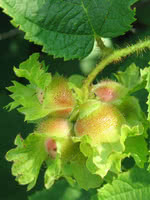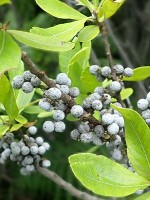Mon-Fri 9am - 5pm Mountain time
American Hazelnut/Filbert vs Northern Bayberry
Corylus americana
Myrica pensylvanica
NOT AVAILABLE THIS SEASON - MIGHT RETURN
NOT AVAILABLE THIS SEASON - MIGHT RETURN
American Hazelnut is a cold hardy, disease resistant, and long-lived nut tree. It is a great choice for a shrub border for wide, open spaces where it will be allowed to spread. Typically used in naturalization projects for its spreading nature, American Hazelnut is ideal for our zone 4 customers.
If you're a zone 3 prairie customer, don't worry! American Hazelnut can still thrive but needs additional care and protection from our harsh prairie climate.
The edible nuts mature from September to October and are usually roasted or eaten fresh. Make sure you take time to notice American Hazelnut's variable and beautiful fall color that ranges from orange, rose, purplish-red, yellow, and green.
Note: You want more than one hazelnut to improve yields.
Northern Bayberry makes an excellent hedge or feature shrub. It will retain its leaves in warmer climates but drops them in colder areas. They produce blue-grey berries that have a wax coating on them that can be used to make candles or soaps.
In colder hardiness zones the leaves turn an attractive orange to red colour in the fall, making it a striking addition to your landscape.
Northern Bayberry is native to Nova Scotia and tolerates both drought and wet conditions. It is also a nitrogen fixer that tolerates poor soil conditions.
American Hazelnut/Filbert Quick Facts
Northern Bayberry Quick Facts
Toxicity: Warning: The wax from bayberry fruit is considered toxic and may be carcinogenic.

